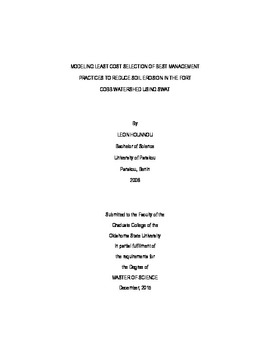| dc.contributor.advisor | Stoecker, Art | |
| dc.contributor.author | Hounnou, Leon | |
| dc.date.accessioned | 2017-02-22T22:12:43Z | |
| dc.date.available | 2017-02-22T22:12:43Z | |
| dc.date.issued | 2015-12-01 | |
| dc.identifier.uri | https://hdl.handle.net/11244/48986 | |
| dc.description.abstract | The main cause of water quality impairment in the United States is due to Non-Point Source (NPS) pollution caused by human activities like agriculture and urbanization. An example is the Fort Cobb Watershed which has limited capability due to soil erosion and phosphorus load. Soil and water conservation practices can be used to mitigate soil erosion, nitrogen and phosphorus inflow from agricultural lands. Some conservation practices have been implemented in the Fort Cobb Reservoir watershed but their cost effectiveness has not yet been assessed. The objective of this study is to determine the most cost effective selection and location of Best Management Practices (BMPs) on farmland to reduce soil erosion and the delivery of sediment and phosphorus to the reservoir. Detailed conservation practices were simulated with the SWAT (Soil and Water Assessment Tool) to determine yields, erosion, and phosphorus loss for each practice by each HRU (a soil type-land use unit) and location in the watershed. Linear Programming was used to determine the cost minimizing choice of BMP(s) for each HRU (hydrologic response unit) that meets sediment and phosphorus targets for the watershed.Of the conservation practices simulated, conservation tillage plus contour farming (66%), conservation tillage plus strip cropping (83%) and conservation tillage plus parallel terrace (95%) are the most effective in reducing sediment loads as compared to the baseline (conservation tillage only). The results of the linear programming maximization of net profit indicate that a combination of management practices is the best option for reducing soil erosion while maintaining a substantial income for the farmers.Key words: Watershed, management practices, optimal choice, SWAT, linear programming. | |
| dc.format | application/pdf | |
| dc.language | en_US | |
| dc.rights | Copyright is held by the author who has granted the Oklahoma State University Library the non-exclusive right to share this material in its institutional repository. Contact Digital Library Services at lib-dls@okstate.edu or 405-744-9161 for the permission policy on the use, reproduction or distribution of this material. | |
| dc.title | Modeling Least Cost Selection of Best Management Practices to Reduce Soil Erosion in the Fort Cobb Watershed Using Swat | |
| dc.contributor.committeeMember | Boyer, Tracy | |
| dc.contributor.committeeMember | Sanders, Larry | |
| osu.filename | Hounnou_okstate_0664M_14457.pdf | |
| osu.accesstype | Open Access | |
| dc.description.department | Agricultural Economics | |
| dc.type.genre | Thesis | |
| dc.type.material | text | |
